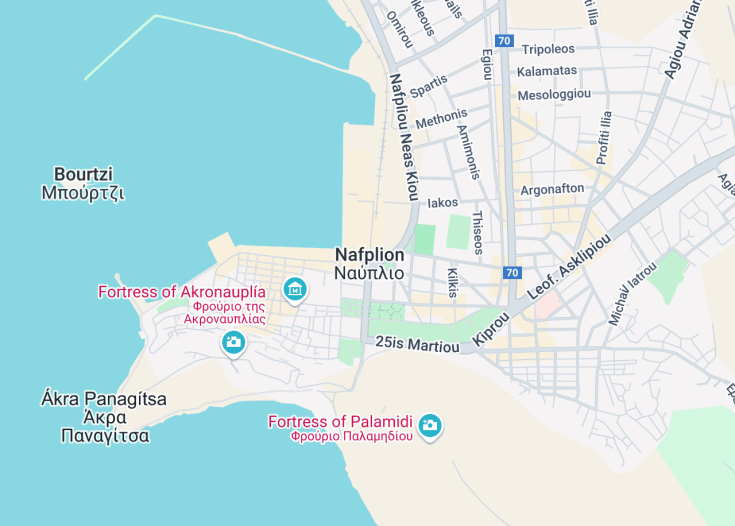Nafplio, often hailed as one of Greece’s most picturesque cities, exemplifies the blend of historical richness and modern elegance. Nestled in the Peloponnese peninsula, this seaside gem served as the first capital after Greece declared independence.
The city’s charm is accented by its Venetian fortresses, Ottoman fountains, and neoclassical architecture, with the Palamidi Castle towering majestically over terracotta rooftops. Nafplio is not only a portal into Greece’s revolutionary past but also a vibrant hub of culture and hospitality, perfect for travelers seeking both enlightenment and relaxation.
Embark on a walking tour early in your visit to capture the essence of Nafplio’s historic heart, navigating its narrow, lively streets before they fill with daily visitors.
Be sure to visit Nafplio in the late spring or early autumn to enjoy mild weather and fewer crowds, enhancing your experience of the city’s rich tapestry of sights and flavors.
Top things to do & see in Nafplio
Select the following sights and activities to discover best tickets and tours available in Nafplio.
Nafplio: A Timeless Beauty by the Sea
| Country | Greece |
| Time in Nafplio | GMT+3 |
| Language spoken | Greek |
| Population | 14,203 (Statista, 2021) |
| Currency | Euro (€, EUR) |
| Airports |
|
Located on the eastern Peloponnese coast of Greece, Nafplio stands as one of the most picturesque towns in the country, rich with history and brimming with culture. Known as the ‘Naples of the East’, Nafplio was the first capital of modern Greece and has been inhabited since ancient times, which is reflected in its varied architectecture and numerous monuments. The city’s charming old town is filled with narrow streets, historic buildings, and beautiful squares, all framed by dramatic coastal and mountain backdrops.
Nafplio’s significance stretches back to the pre-classical era but its most visible landmarks date from the Venetian rule in the 15th century, especially Palamidi, a fortress towering above the town. The Bourtzi, a small fortress on an islet in the harbor, adds to the city’s scenic and historical appeal.
Nafplio’s allure is not just in its rich history and stunning views, but also in its vibrant local life, with bustling tavernas, seafront cafés, and museums like the Komboloi Museum and the War Museum. The city hosts classical music festivals that bring a contemporary vibrancy to this ancient setting. By evening, the city holds a romantic ambiance as the streets come alive with people enjoying the nightlife and the warm Mediterranean breeze.
For visitors, Nafplio offers a wealth of experiences from historical tours exploring ancient ruins and forts, to leisurely pursuits like boating or swimming near Arvanitia beach. The town also serves as a gateway to exploring the archaeological treasures of the Peloponnese, including Epidaurus, Mycenae, and Tiryns.
Where is Nafplio?
Nafplio is located in the Argolis prefecture of the Peloponnese peninsula in Greece.
Distances:
| Route | Distance by car | Time by car |
|---|---|---|
| Athens to Nafplio | 94 miles (151 km) | Approximately 2 hours |
| Thessaloniki to Nafplio | 342 miles (550 km) | Approximately 5 hours 30 minutes |
What is Nafplio famous for?
Nafplio is renowned for its well-preserved architecture, historical significance as the first capital of Greece, and its striking medieval castles and fortresses like Palamidi and Bourtzi, symbols of its storied past.
History
Prehistoric to Classical Era
Nafplio, one of Greece’s most historic cities, is believed to have been settled as far back as the prehistoric period, with its name deriving from Nafplios, the son of Poseidon. Early settlements show that the area was an important center during the Mycenaean civilization, highlighted by its proximity to the legendary cities of Tiryns and Mycenae. The prominence of the area continued into the Classical Greek period, aligning Nafplio with powerful maritime ventures and trading.
Middle Ages to Venetian Rule (1204-1540)
Following the Fourth Crusade, Nafplio entered a period of varied foreign control, beginning with the Franks and later passing into Byzantine hands. The city thrived under Venetian rule starting in the late 14th century, which fortified the city and shaped much of its aesthetic architectural heritage. Venetian influence remains prominent in Nafplio’s old town, where medieval and Renaissance structures blend seamlessly.
Ottoman and Venetian Rule (1540-1821)
Control over Nafplio alternated multiple times between the Venetians and the Ottomans during this period, reflecting the broader struggle for dominance in the Mediterranean region. Each tenure left unique imprints, particularly the Ottomans, who constructed mosques and baths, integrating them with the older, Venetian-built structures, resultant in a rich, cultural mosaic that is visible to this day.
Modern Greece (1821-Present)
Nafplio holds a prestigious place in modern Greek history as the first capital of the newly established Greek state after the war of independence against the Ottomans in 1821. The city was officially the capital until 1834, when Athens took over the role. Today, Nafplio is celebrated for its well-preserved historical architecture, vibrant cultural scene, and as a beloved destination for both Greek and international tourists.
Visit Nafplio
What to See and Do in Nafplio
Exploring Nafplio is akin to walking through a living museum, with its rich heritage visible in every corner. Key attractions include the imposing Palamidi Castle, which offers spectacular views of the town and bay.
The Bourtzi sea fortress, accessible via a short boat ride, is another must-visit. The cobbled streets of the old town are lined with neoclassical mansions, quaint cafes, and boutiques, providing an ideal setting for leisurely walks. Among the city’s museums, the Archaeological Museum of Nafplio and the War Museum offer insights into the city’s significant past.
- Palamidi Castle
- Bourtzi Fortress
- Archaeological Museum of Nafplio
- Old Town exploration
Festivities and Celebrations in Nafplio
Nafplio hosts numerous cultural and historical events throughout the year, reflecting its rich heritage and vibrant community. The Nafplio Festival in summer features music, dance, and theatrical performances, filling the historic squares and fortresses with art and culture.
Another notable event is the Nafplio Marathon in spring, attracting participants from across the globe.
Best Time to Visit Nafplio
The best time to visit Nafplio is during spring (April to June) and fall (September to November). During these months, the weather is pleasantly mild, perfect for exploring the city’s extensive historical sites and natural beauty without the peak summer crowds.
Is Nafplio Worth Visiting?
Indeed, Nafplio is worth visiting. This picturesque city not only offers a journey through the annals of Greek history but also provides a stunning natural setting with expansive views of the Argolic Gulf.
Its vibrant cultural life, highlighted by festivals and local events, adds to the city’s allure, making it an ideal destination for tourists seeking both historical depth and contemporary leisure activities.









